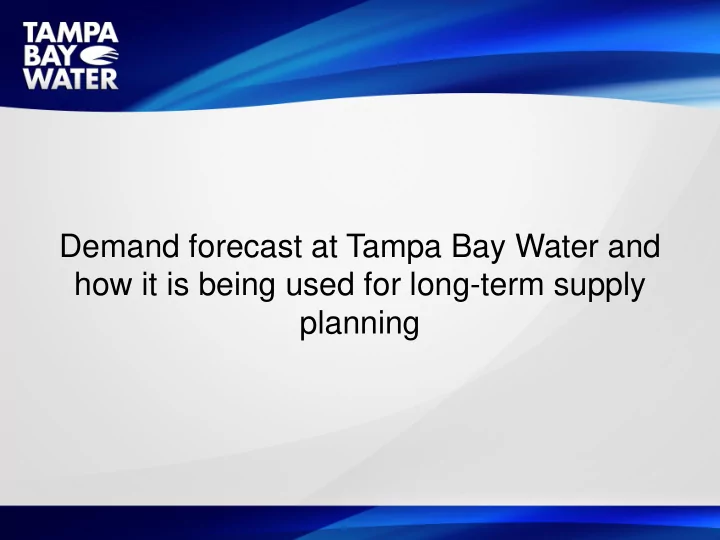

Demand forecast at Tampa Bay Water and how it is being used for long-term supply planning
Agency’ Mission Tampa Bay Water reliably provides clean, safe water to the region now and for future generations
What drives long-range demand forecast? • Master water supply contract: – States the agency has unequivocal obligation to supply water If demand exceed permitted capacity by 75% during any twelve month period, initiate a preparation of permit applications for new supply projects; If demand exceed permitted capacity by 85% during any twelve month period, file permit application; and If actual delivery during any 12-month period exceeds 94% of aggregated permitted capacity, it is considered a production failure
“Forecasting is the art of saying what will happen, and then explaining it why it didn’t” -Anonymous
Forecasting Methodology Sector Water Use (Q) = Average Rate of Use Number of Users X (q = unit use) (N = drivers) • housing units • per household • employment • per employee
Disaggregated Framework • Rate of use reflects monthly average gal/unit/day for each • Sector • Month/Year • Geographic unit • Total use for each sector, month/year, geographic unit reflects: • Average rate of use per unit • Number of units
TAZ Geographical Modeling Unit • TAZ geographies – Defined: Florida Dept. of Transportation (FDOT) – 1800 across region – Growth projections available • TAZ maps to WDPA
Modeling Approach uses TAZ as Modeling Unit • Observations for water use aggregated/averaged to the Traffic Analysis Zone (TAZ) level – Provides large number of geographic cross-sections – Rich source for estimating model parameters • Socioeconomic variables collected at TAZ level – Income – Housing density – Persons per household – Housing units – Employment and distribution of employment
Other modeling data assigned to TAZ • Weather variables – Data collected from multiple weather reporting stations – TAZ-level values derived through distance- weighting • Data collected from or derived from member data – Price of water – Fraction of accounts with access to reclaimed water
Model Variables/Drivers: Relative Effects on Demand Forecast VARIABLES/DRIVERS EFFECT Housing units (SF&MF) +++ Total Employment (NR) ++ Fraction of Employment by Major Employment Sector + Median household income (SF, MF, NR) ++ Housing density (SF&MF) - Persons per household (SF) + Marginal price (SF) - - Temperature departure (SF) + Rainfall departure (SF&NR) - Rainfall (MF) - Number of Rainy Days (SF) - Fraction of reclaimed accounts (SF&MF) -
Aggregation of Sectors Retail Single-Family Demand Demand + Multifamily Demand Total + Production Nonresidential Demand Demand + Wholesale + Other/Unbilled
Probabilistic Demand Forecast • For a given demand slice, e.g., 2005 Forecast 2030 – A range of socio- 2001 Forecast economic factors were used – Longterm rainfall and temperature values used
Schematic of Operational Model Long-term Demographics LTDFS Demand & Weather (Monthly) Latin Realizations Hypercube Sampling Flow Modeling 100-Year Historical System Streamflow Climate Data (Monthly) Realizations Surface Water Availability Model Flow (Daily) Network Demand-Flow Description Inter-Process Communication Pair Realizations TBW System Operational Operations Model Constraints (Daily) Prescribed Operations Desal Schedules Production
Use of long-range forecast A) Results of Additional Supplies by 2025 Compared Against Existing System Policy Level Existing Supply 5 MGD 10 MGD 15 MGD 20 MGD Reliability Reliability Reliabiliy Reliability Reliability A 42% 54% 65% 72% 79% B 82% 89% 94% 95% 96% C 93% 95% 97% 99% 99% D 96% 98% 99% 99% 99% B) Results of Additional Supplies by 2030 Compared Against Existing System Policy Level Existing Supply 5 MGD 10 MGD 15 MGD 20 MGD Reliability Reliability Reliabiliy Reliability Reliability A 30% 40% 48% 56% 65% B 68% 75% 81% 88% 91% C 81% 87% 90% 93% 95% D 87% 91% 94% 95% 98% C) Results of Additional Supplies by 2035 Compared Against Existing System Policy Level Existing Supply 5 MGD 10 MGD 15 MGD 20 MGD Reliability Reliability Reliabiliy Reliability Reliability A 25% 33% 38% 45% 53% B 54% 61% 70% 78% 81% C 67% 78% 80% 86% 88% D 76% 81% 85% 90% 93%
Recommend
More recommend